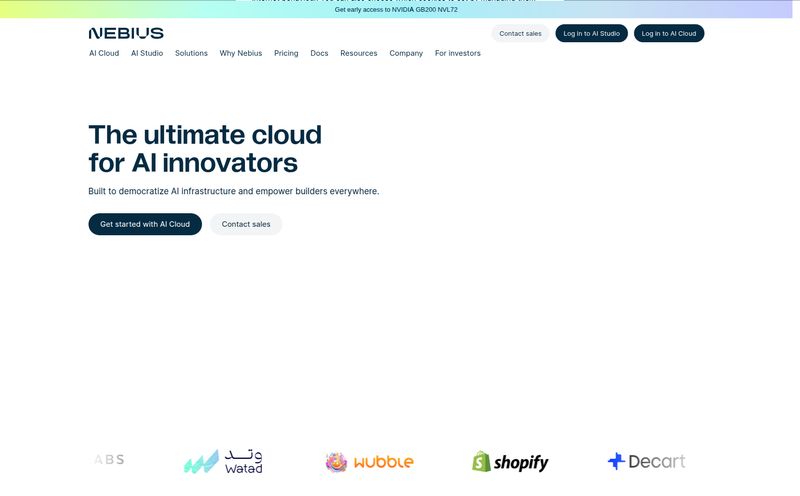We've all been there. You're staring at a blank input field for ChatGPT, Claude, or whatever AI coding assistant is the flavor of the month, trying to conjure the perfect spell... I mean, prompt. You need it to build that sleek new landing page component, but your words just aren't translating into the code you see in your head. It's frustrating, right? You spend more time trying to describe the thing than it would take to just... build the thing.
It’s one of the weirdest new bottlenecks in our industry. We have these incredibly powerful AI tools, but they’re only as good as the instructions we give them. The whole 'prompt engineering' craze is a testament to that. But what if you could just skip half the battle? What if you could just... show it a picture?
That's the promise of a tool I've been playing with recently called CopyCoder. And I’ve got to say, my curiosity is definitely piqued. It claims to generate powerful prompts for AI coders directly from an image. A UI mockup, a screenshot, a custom design – you name it. So, is it the real deal or just another gimmick in the AI gold rush? Let's get into it.
So, What Exactly Is CopyCoder?
Let's be clear from the jump: CopyCoder isn't another AI that writes code for you. Think of it more like a brilliant translator or a creative director for your actual AI coding assistant. It bridges that frustrating gap between a visual idea and a detailed, technical brief that an AI can actually understand and execute on.
You upload a visual representation of what you want to build—say, a slick hero section from a site you admire or a detailed mockup from Figma—and CopyCoder’s AI gets to work. It analyzes the layout, the components, the colors, and the structure. Then, it spits out a comprehensive, text-based prompt that you can copy and paste directly into your preferred AI tool to generate the code. It’s a pretty slick concept, I have to admit.
The Big Idea: From Image to Actionable Code Prompts
The workflow is about as straightforward as it gets, which is something I always appreciate. We have enough complexity in our lives, you know?
1. You find an image. This could be a screenshot, a professional UI design, or I guess even a really, really clean napkin sketch (though I wouldn't recomend it).
2. You upload it to CopyCoder. On the dashboard, you pick your project type, like a landing page, and feed it the image.
3. It generates a prompt. The AI does its magic and provides a detailed description of the UI, broken down into a structured prompt that's ready for use.
Instead of you typing out "Create a div with a dark background, containing a heading in a large sans-serif font and a subheading below it... oh, and a purple button with rounded corners," CopyCoder does the heavy lifting for you. It's designed to see the UI and describe it with the specificity that an AI coder needs.

Visit CopyCoder
Let's Talk Features That Actually Matter
A tool is only as good as its features. CopyCoder keeps it pretty focused, which I think is a strength. It's not trying to be a bloated, all-in-one platform. It does one thing, and it aims to do it well.
The AI Builder and Clone UI
These seem to be the core of the platform. The "Clone UI" functionality is exactly what it sounds like, and it's probably the main draw for many people. See a design you like? Clone it. Or, at least, get a prompt that will help your AI clone it. The AI Builder (currently in Beta, which is always exciting) seems to be the engine that powers all of this, taking the visual data and structuring it into a logical prompt. This is where the real secret sauce is.
Template Library Access
Both paid plans give you access to a complete template library. This is a smart move. Sometimes you don't have a specific design to copy; you just need a solid starting point. Having a library of common layouts and components means you can get moving even faster. I haven't seen the full library, but the inclusion of one is a big plus for workflow efficiency.
How Much Does CopyCoder Cost?
Alright, the all-important question: what's the damage? CopyCoder uses a pretty standard two-tiered subscription model. It’s refreshing to see straightforward pricing without a million hidden add-ons.
| Plan | Price | Key Features |
|---|---|---|
| Starter Plan | $15 / month | 1 project, Clone UI, AI Builder (Beta), Template Library, Standard support |
| Pro Plan | $39 / month | Unlimited projects, Clone UI, AI Builder (Beta), Template Library, Priority support |
Starter vs. Pro: What's the Real Difference?
Honestly, the choice here is pretty simple. If you're a hobbyist or just want to try it out for a single project, the Starter plan at $15 is a low-risk entry point. But for any freelancer, agency, or serious builder, the Pro plan is the only one that makes sense. The jump to unlimited projects for $39 a month is a no-brainer if you plan on using this regularly. The priority support is a nice little bonus, too.
The No Free Trial Question
You'll notice there isn't a free trial. Their FAQ is upfront about it: "No we do not currently offer a free trial, because everytime you use our platform we incur costs from the AI model provider." I actually respect this. It's honest. Running these AI models isn't cheap, and it filters out people who aren't serious. It suggests they're confident enough that once you're in, the value will be obvious.
My Honest Take: The Good and The Not-So-Good
So, after kicking the tires, what's my verdict? Like any tool, it’s not perfect, but it’s definitely compelling.
The Good Stuff
The primary benefit is speed. The potential to slash the time spent on prompt iteration is huge. For developers who get bogged down in frontend grunt work or for agencies that need to prototype rapidly, this could be a game-changer. It’s also fantastic for bridging the communication gap. A designer can hand over a mockup, and CopyCoder can generate the technical brief, ensuring everyone is on the same page. It democratizes the process, and I’m all for that.
A Few Caveats
Now, for a dose of reality. The age-old principle of "garbage in, garbage out" applies here more than ever. The effectiveness of CopyCoder is entirely dependent on the quality of the image you provide. A blurry, low-resolution screenshot won't magically transform into a pixel-perfect prompt. You need clear, well-structured mockups for the best results.
My biggest question mark is around the specifics of the prompts. Are they generic, or are they optimized for certain AI models like GPT-4 versus Claude 3 Opus? As experts at Smashing Magazine will tell you, different models respond better to different prompt structures. Advanced users will want to know more about this. For now, it seems to generate a solid, universal prompt, which is a great start.
Who Should Actually Use CopyCoder?
- Rapid Prototypers & Freelancers: If your job involves churning out MVPs, landing pages, or quick website builds, the Pro plan could pay for itself in a single project.
- Visually-Minded Founders: Got the vision but not the technical jargon? This tool can translate your Figma designs into something an AI (or a developer) can immediately work with.
- Frontend Developers with Better Things to Do: Let's be honest, setting up basic HTML/CSS boilerplate is tedious. Offload that initial step to AI, and use CopyCoder to make sure the AI gets it right the first time.
Final Thoughts: A Prompt in the Right Direction?
So, is CopyCoder worth it? In my opinion, yes, for the right person. It's not a magic wand that eliminates the need for skill, but it is a fantastic force multiplier. It automates one of the most tedious new tasks in the modern developer's workflow: writing painfully detailed instructions for a robot.
By turning visual language into technical prompts, it saves time, reduces friction, and could genuinely help you build apps and websites faster. The world of AI-assisted development is moving at a breakneck pace, and tools like CopyCoder are a sign of a maturing ecosystem. It's a clever solution to a very real problem, and I'm excited to see how it develops from here.
Frequently Asked Questions
- Does CopyCoder actually write the code for me?
- No, and this is a key distinction. CopyCoder generates highly detailed prompts that you then use with an AI coding tool (like ChatGPT, Claude, etc.) to generate the actual code. It prepares the instructions; it doesn't do the final build.
- Can I upgrade or downgrade my plan anytime?
- Yes, according to their site, you can change your plan at any time. The changes will be reflected in your next billing cycle, giving you immediate access to the new features if you upgrade.
- Is there a free trial for CopyCoder?
- No, there is no free trial. The company explains this is due to the costs they incur from the AI model providers each time the service is used. You have to jump in with the $15 Starter plan to get started.
- What kind of images work best with CopyCoder?
- For the best results, you should use high-resolution, clear images. Professional UI mockups from tools like Figma or Adobe XD, or crisp, clean screenshots of existing websites, will yield much better prompts than blurry or ambiguous photos.
- What payment methods do you accept?
- They accept all major credit cards, including Visa, Mastercard, American Express, and Discover, processed securely through Stripe.
- Is CopyCoder a replacement for a human developer?
- Absolutely not. It’s a tool designed to make a developer's job easier and faster. It enhances the workflow, especially for frontend tasks, but it doesn't replace the critical thinking, problem-solving, and architectural skills of a real developer.



